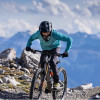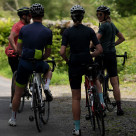Knowledge Level: Intermediate
Winter riding can be one of the most rewarding and invigorating experiences on the bike - frosty landscapes, crisp air, and quieter roads or trails. Staying warm and dry is key to making it enjoyable rather than a battle against the elements.
Whether you’re training on the road, tackling muddy off-road trails, commuting, or competing in cyclocross, knowing how to layer up and protect yourself from the cold, wind, and rain is essential.
This guide provides practical advice to help you maintain comfort and performance throughout the colder months.
Route choice
Taking extra time to plan your route wisely can make all the difference in winter. Hillier terrain may lead to overheating on the climbs and then cooling down on the descents, as sweat rapidly lowers your body temperature. Opting for a flatter route allows for a more consistent effort, keeping your temperature steady and reducing the need to stop and adjust layers.
For those who enjoy off-road riding - whether that’s mountain biking, cyclocross, or gravel - winter can be an excellent time to hit the trails.
Disabled riders using adapted bikes may need to consider surface conditions even more carefully, as handcycles and trikes can have different stability and traction needs in winter weather.
Preparation before heading out
-
Fuel your ride - Start with a breakast or snack to keep your energy levels up. Low blood sugar can make you feel colder and reduce your ability to sustain effort.
-
Stay hydrated - It’s easy to forget about hydration in winter, but it’s just as important as in summer. Consider using insulated bottles with a warm drink, such as green tea with honey, to help maintain body temperature.
-
Pre-warm your kit - Placing your shoes, socks, and gloves near a radiator can give you a cosy start.
-
Avoid overdressing – a common mistake is to layer up too much, leading to excessive sweating and then rapid cooling. Start off feeling slightly chilly - your effort will warm you up quickly.
Head, face, and neck
- A non-vented aero-style helmet can help retain warmth, especially when paired with a windproof skullcap or other head covering.
- Clear or light-enhancing lenses protect your eyes from road spray and cold winds, improving visibility in dim winter light.
- A form of snood or neck gaiter will keep your neck warm and can be pulled up over your face when needed. Make sure it allows enough airflow to prevent glasses from fogging up.
- For some riders, including those using adaptive supports or communication devices, ensuring headwear does not interfere with comfort or functionality is vital. Opt for lightweight but insulating options that allow easy movement for you
Hands
Cold hands can make braking and shifting difficult and turn an enjoyable ride into a miserable one. To avoid this:
- Choose insulated, windproof, and waterproof gloves that allow for good dexterity.
- Make sure gloves aren’t too tight, as restricted circulation will make your fingers even colder.
- Lobster-style gloves or mittens can provide extra warmth, but test that they allow easy operation of your brakes and gear levers.
- Always tuck your jacket cuffs over your gloves to keep the cold and rain out.
- Riders who experience circulation challenges or reduced mobility may benefit from heated gloves, bar mitts, or handlebar covers to maintain warmth and dexterity.
Read more about keeping your hands warm on the bike.
Body
A proper layering system is key:
-
Base Layer - A close-fitting, moisture-wicking base layer helps regulate body temperature. For extra warmth, consider one with a windproof front.
-
Mid-Layer - A winter-weight cycling jersey or a modern weather-resistant jersey provides insulation and breathability.
-
Outer Layer:
- For cold, dry days - a lightweight windproof jacket or gilet may suffice.
- For wet weather - a packable waterproof can be a lifesaver.
- For persistent rain and extreme cold - a heavier-duty waterproof jacket with taped seams offers the best protection.
For cyclists who may generate less body heat due to reduced movement, prioritising effective layering with extra insulation, especially around the core, can help maintain warmth and comfort over long rides.
Legs
Your lower body does a lot of the work, but it still needs protection:
- Bib tights provide excellent insulation and coverage, particularly for the lower back.
- Look for windproof and water-resistant front panels while ensuring breathability at the rear.
- Ankle zips help with easy fitting, especially over overshoes or booties.
- For riders using recumbent bikes or handcycles, additional windproof leg covers or lap blankets provide extra warmth and protection from the elements.
Feet
Keeping feet warm and dry is one of the biggest challenges in winter. Here are some ways to keep yours…
- Try wearing knee-length socks; they can provide insulation without excessive bulk.
- Consider waterproof, merino-lined socks for extra protection.
- Use overshoes to shield from wind and rain, ensuring they cover your shoe vents.
- If using dedicated winter cycling shoes, size up slightly to allow for thicker socks.
- Ensure full-length mudguards are fitted to your bike to reduce spray and keep feet drier.
Read more about keeping your feet warm on the bike.














